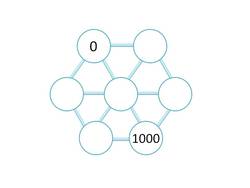Puzzles are really fun!
 Each circle has three or six neighbors, and the number placed in each blank circle must be the average of its neighbors. What is the largest of the five missing numbers?
Each circle has three or six neighbors, and the number placed in each blank circle must be the average of its neighbors. What is the largest of the five missing numbers?
The answer is 625.
This section requires Javascript.
You are seeing this because something didn't load right. We suggest you, (a) try
refreshing the page, (b) enabling javascript if it is disabled on your browser and,
finally, (c)
loading the
non-javascript version of this page
. We're sorry about the hassle.
2 solutions
Discussions for this problem are now closed
Let a , b , c , d , e be the missing numbers, from top to bottom, reading from left to right. (That is, c is the center one, a , b are adjacent to 0 ...) We obtain the five equations: ⎩ ⎪ ⎪ ⎪ ⎪ ⎪ ⎪ ⎨ ⎪ ⎪ ⎪ ⎪ ⎪ ⎪ ⎧ 3 a = 0 + c + d 3 b = 0 + c + e 6 c = 0 + a + b + d + e + 1 0 0 0 3 d = a + c + 1 0 0 0 3 e = b + c + 1 0 0 0 Solving the system above gives ( a , b , c , d , e ) = ( 3 7 5 , 3 7 5 , 5 0 0 , 6 2 5 , 6 2 5 ) , thus the largest is 6 2 5 . Solving the system should be simple enough. (I used the first and fourth equations to obtain a + d in c , as well as b + e with the second and fifth, so substituting to the third equation gives c . I then plug them back into the first and fourth equations to get a , d , and second and fifth to get b , e .)
saya masih belum paham -_-"
What about zero ? I think it's neighbours can't generat zero !!
Average of 5 missing numbers. 0 is not missing
maybe unclear instruction. But 0 and 1000 does not refer to the "average of its neighbours" part which are just 0 and 1000 as they are so you don't need to find that its neighbours' average is 0 or 1000.... damn instruction 0 does not (A + B + C)/3
You can consider 7 unknowns ..then take 0 and 1000 known
Use the symmetry to simplify. You can subtract any number from all circles so subtract 500. There is reflection symmetry about two axis. The solution will be symmetric about one and anti-symmetric about another. The centre number must therefore be zero and the others x,-x,-x,x giving just one equation to solve (500+x)/3 = -x, x = 125. Now add the 500 back on to get the answer 125+500=625.